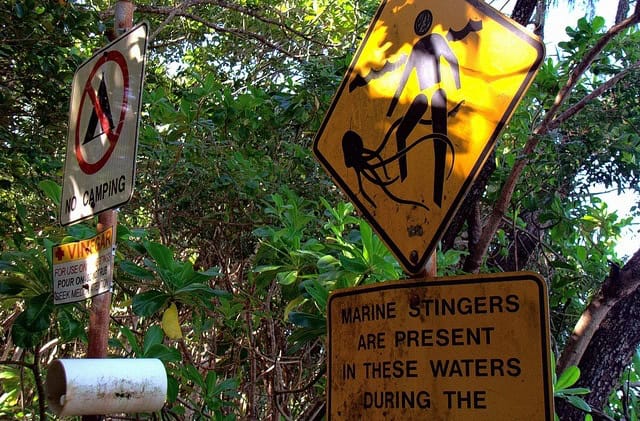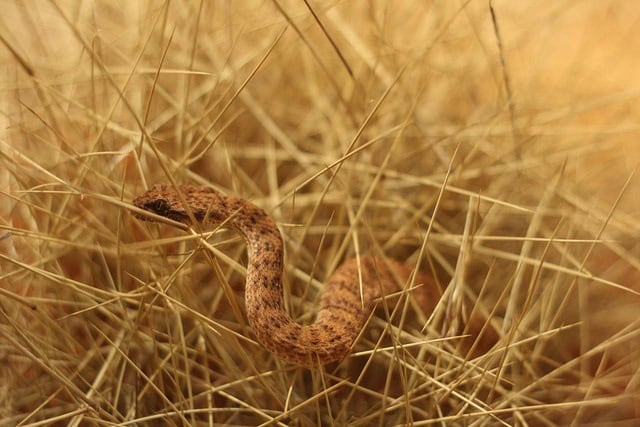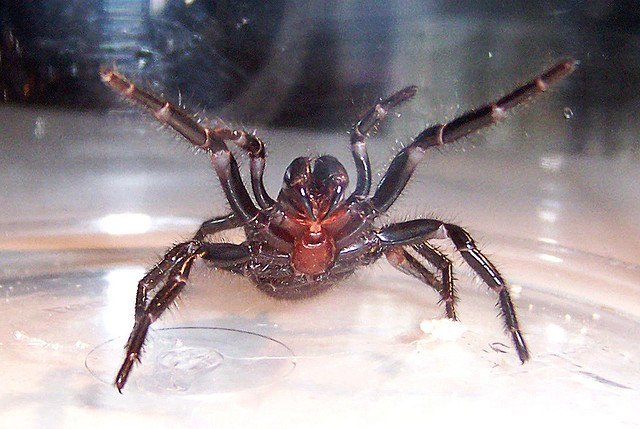
I moved to Australia in March of 2009. As hard as it is to believe, I've been here for about 3.5 years, and guess what – I'm still alive!
With all the hype on Australia having one of the harshest climates and being home to the world's deadliest creatures, you know… not very many people have actually died from them.
Still, it is one of the first things I hear about from family and friends back home.
“Oh, I couldn't go there! They have so many snakes and spiders that can kill you!”
True. There are plenty of things that could kill you (and it's probably a good idea to have comprehensive travel insurance), but the facts point to driving and even horseback riding to being deadlier in nature.
Here are the facts about Australia's deadly animals!
Table of Contents
Spiders
In the past 3.5 years, I've been face-to-face with several arachnids – most of them being simple orb spiders or the ugly, ugly huntsman.
Those, luckily, are not dangerous to humans in the least.
On the dangerous end of the scale, I've heard of a friend finding a Sydney funnel-web in his basement (not too far from my home) and my flatmates finding a Redback Spider out on our front porch.
Yes, both of these spiders are considered to be some of the deadliest in the world because of their potential, but the fact is they rarely kill.
The Redback Spider, a relation to the black widow, bite actually only affects about 10% of people who have an adverse reaction to the venom.
You'll be happy to know that no person has died from a spider-related bite since 1979, as antivenom is now available for all native species.

Sharks
Australia is an island country, with close to 60,000 kilometers of coastline and deep ocean in its surrounds.
These oceans are home to Great White sharks, Tiger sharks, and Bull sharks.
Okay, so it's been a bad year for shark attacks, especially off the coast of Western Australia, but hear me out.
According to an article from Australian Geographic, of the 877 shark attacks in Australia since 1791, that's over 221 years, only 216 have been fatal.
That works out to be about one fatality per year.
Since 2000, the number has been a little more at just two fatalities per year.

Snakes
The world's deadliest land snake, the taipan, calls Western Australia home.
Besides that, you can find the brown snake, the death adder, and the tiger snake – all of which are considered the world's deadliest.
Sure, snakes are a scary business in Australia, but how scary?
It turns out that up to 3000 Australians get bit by snakes each year, but just an average of two a year are fatal.
Of those, the majority are caused by the brown snake.

Crocodiles
I must admit, it is a little off-putting when you reach the most spectacular and gorgeous beach in the tropical north of Australia just to be met with a sign that reminds you that there may be crocodiles in the vicinity.
Recent studies that point to the crocs being able to travel long distances by “catching waves” are also a little disturbing.
The last thing you want to see while catching some rays is a crocodile rocking up on the beach next to a surfer!
Still, those pesky crocs actually cause fewer than two fatalities per year in Australia.
Box Jellyfish
The Box Jellyfish is tiny but deadly.
I remember seeing one on display in a jar at a caravan park in the tropical north of Queensland to warn visitors, and to think that little thing – almost clear in color – could be so ruthless was shocking.
With the box jellyfish, a person can go into cardiac arrest within minutes.
This depends on the amount of tentacle that touches the body.
To deactivate the tentacles' stinging cells, vinegar has to be poured over them for at least 30 seconds.
Luckily, these jellyfish only populate the tropical north's waters from October through April.
Another plus is that these little jellyfish don't cause more than 1 death per year on average.
Pin for Later
Brooke lives a thrifty lifestyle so that she can travel the world at every possible opportunity. Find more of her writing on her website: Her Packing List. Or follow her on Twitter.
Planning a trip? Go Backpacking recommends:
- G Adventures for small group tours.
- Hostelworld for booking hostels.




John
Monday 18th of April 2016
I saw a doc once about horrible non-indiginous frogs that are wiping out Australia's wildlife. Can't remember the name but I think they're Brazilian. Introduced in the 1960's. They have hideous postules that produce acidic puss. Eeww. Kills anything that eats them.
Toby
Saturday 8th of October 2016
I'm pretty sure you're thinking of cane toads; no one likes them and we'll kill them if we get the chance.
Parisa
Wednesday 27th of January 2016
These spiders freak me out.... how often would you run into a spider in urbun areas like center of Melbourne? I'm considering the universities there for PhD but the spiders scares me to death.
LC Haughey
Saturday 30th of January 2016
Hi Parisa. They're around, but you'll be fine. The funnel web is mostly found in Sydney and redbacks are far and few between (just make sure to check your shoes before you put them on as well as under the toilet seat!).
No one I know has ever been bitten by anything. I stepped on a brown snake when I was younger, barefoot too and I'm here to tell the tale.
Go to Melbourne! You'll love it.
Marcello
Tuesday 26th of January 2016
3000 snake bites a year?! That is really scary! Especially when you consider that those cases in which people get permanently injured as a consequence aren't included in the 2 people a year dead count. I saw in a documentary once a man who ended up with permanent muscular dysfunction following a venomous snake bite in Australia
John
Monday 26th of November 2012
I found a Brown Snake in our house when I was a kid. We renovated after this.
Karsten
Monday 22nd of October 2012
Correction to the jellyfish comment, box jellies are a decent size (easily spotted on a boat for example). The small jellyfish are irukandji which are tiny.
Krys, 3 days in Tassie can be done but you are probably best to stick to one region, south, north east or north west. Fly into Hobart or Launceston. Personally I suggest a weekend in Hobart, Salmanca markets on Saturday, cruise up to MONA (Museum of Old and New Art, closed Tuesday, costs $20 for non Tasmanians, return ferry is $15). Farmers market on Sunday morning, lunch at Garagities (only takes bookings on Sunday arvo, set menu), Ethos is also go and Mee Wah is the best restaurant in Tasmania and does a good yum cha.
The great ocean road has a few spots were one can stop for a picnic. As for scary creatures Victoria has quite a few snakes. One thing is be careful with ants, the jack jumper has an ancient wasp like sting that sends 3% of victims into anaphylactic shock and has caused more deaths in Tasmania than snakes, spiders and sharks combined.